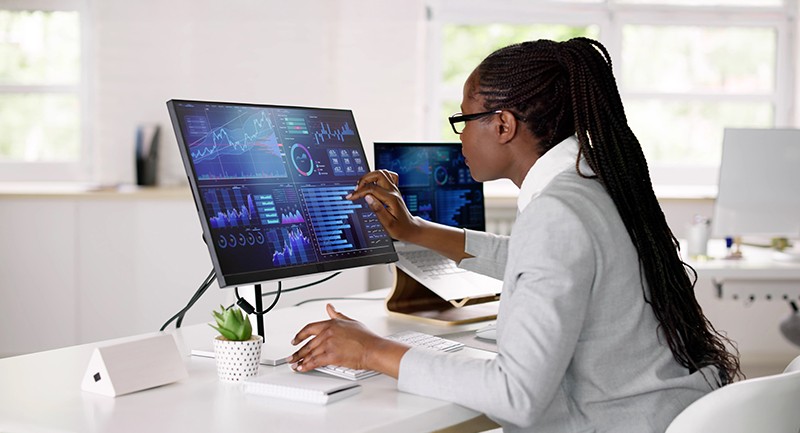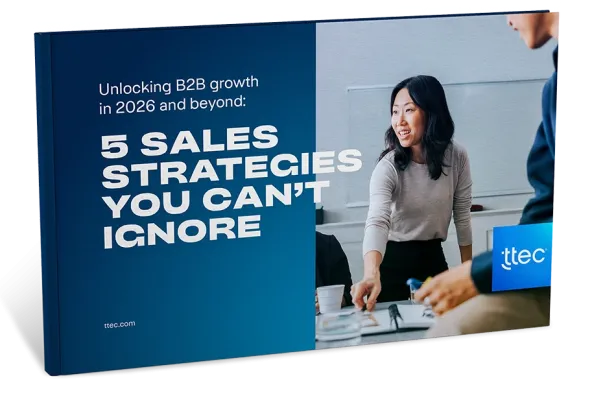“With great power comes great responsibility.” That proverb may be traced to Voltaire and Spider-Man, but it’s contact center leaders who see the impact data and analytics are already having on the front line — and the obligations that come with it.
Forward-thinking leaders who prioritize the customer experience across a wide range of business sectors shared their insights, experiences, and some cautionary tales with CCMA earlier this year. The resulting new report, “Bringing the power of data and analytics to the front line,” captures best practices for leveraging data analytics to transform the contact center.
Particularly noteworthy is the consensus among CX leaders that contact center associates’ role cannot be overstated. Powerful tools hold great potential for frontline associates to improve the experience but add risk if not carefully thought through and delegated to the appropriate frontline and leadership roles.
The report’s respondents represent an array of business sectors, from banking and financial services to technology, transportation, insurance, hospitality, travel, entertainment, retail, and the public sector. Despite the diversity, the findings led to five discoveries relevant to all business verticals heading into 2025.
The five discoveries highlighted in the CCMA report are centered around responsible and ethical deployment of data analytics — where it can yield the greatest benefits while resisting temptation to overreach into unproven use cases.
Empower associates with dynamic dashboards
Frontline associates are not merely cogs in a wheel; they are eager to track achievements. Accessing their own KPIs through personal dashboards provides the visibility they seek — in real time. It’s imperative that the interpretation of data, however, is left to leaders, not front-line workers, survey respondents emphasized.
“When you use lagging metrics at the end of the month, it’s very hard for agents to truly understand what drives the score. Now you can have agents self-correcting,” said Peter Tubb, head of Global Trading Services, IG Group.
Associates welcome real-time feedback, said Daniel Nield, head of bike operations and live chat at insurance broker Atlanta Group. “People want to know their quality scores without waiting for their coaching session or scheduled update. ‘What do I need to work on?’ They can use that data to start eliciting conversations with their peers and with their managers, whereas at the moment it’s very one-way.”
Keep contact center KPIs simple
Information overload is a very real risk when leveraging data and analytics. CX leaders need to be selective about which KPIs to share with frontline associates. Too much data can be head-spinning and put focus on the wrong areas. When leaders correctly interpret an associate’s KPIs, they can coach that individual in meaningful ways that lead to an improved experience for customers.
“Make it simple and make it short. Not having to look at many different numbers to get to what you need to know. Surface the things that are important,” said Nick Coleman, senior manager of customer care at Dunelm, a home furnishings retailer.
One report participant recalled the data overload he confronted: “My teams were presented with every data element they could possibly have: Case file closures, AHT, call answer rates — whatever you could think of. It drove a focus on the numbers, not service,” said Luke Squires, operations director, Sykes Holiday Cottages. Reprioritizing KPIs — an 18-month process — made service quality associates’ responsibility while management was accountable for service levels. As a result, NPS rose to the 70s while CSAT and answer rates broke records at the vacation rentals company.
Use speech analytics to inform training, strategy
Speech analytics are low-hanging fruit too juicy to resist, and no industry vertical is priced out. With large language models (LLMs) to analyze contact center conversations, organizations get an early warning system that flags emerging issues before they snowball, identifies at-risk customers before they’re lost for good, and highlights types of interactions that require skillful handling and perhaps extra training.
“We’ve been able to understand a lot more in the short time that we've had speech-to-text,” said Sharon Oley, customer services director at software company Sage Group. “If a customer is showing some signs of dissatisfaction and potentially going to leave us, we’re able to then delve into those calls or chats and understand why.”
The Very Group, an online retailer and financial services provider, leverages speech analytics to better understand difficult topics that warrant extra time to handle with empathy. The system also cues associates to take a break after a taxing, emotionally charged interaction.
“We can go to our agents who are our best performers on certain topics and say, ‘What are you doing differently?’ That means you can give great outcomes to the customers and reduce AHT for these particular topics. And we can inform our training teams who onboard new agents to focus on these difficult topics,” said Luke Ollerhead, senior insight manager, The Very Group.
Speech analytics enables Atlanta Group to be proactive. “Now, if we see a surge in customers stating something, it’s automatically flagged so we can start analyzing and fixing at it straight away,” said Nield.
Deliver better, faster resolutions with AI-powered knowledgebases
Wide variance in how organizations leverage — or don’t use — knowledgebases defies logic. AI-driven tools like agent assist have proven their value interpreting and anticipating customer needs and serving up the right answers for faster resolution.
Agent assist prompts contact center associates as to what they might do next, depending on what the customer is saying, said Nicola Mayers, senior customer contact manager at railway Network Rail Ltd.
“About 80% of your calls will be memorable from an agent’s perspective in terms of providing the right answer. But it’s the 20% that you can’t remember that are really important,” said Michael Sherwood, head of brand and experience, Atom Bank. It’s that 20% of interactions that tend to be more complex and merit more time to deliver quality CX.
“Our knowledgebase also captures the reason for contact. You can see the top reasons for customers ringing in,” Sherwood added.
Embrace the changes technology brings
The final, perhaps most compelling discovery unearthed by CCMA’s report is not just how the role of associates is changing but how the contact center is being reinvented.
“You have to be prepared for the job role and the skill sets to fundamentally change,” said Dunelm’s Coleman. “If I’ve employed people in the past to click buttons and follow processes, but now I’m asking them to deliver what the machine has generated rather than generate it themselves, I’m now employing communications people — not people who follow process maps.”
Report participants recognize that change is not easy. Implementations can fail. Resistance to new technology, processes, and roles is to be expected. Concerns about jobs lost to AI and automation is very real. That means contact center leaders are obligated to reassure and educate.
“We have to take away the fear that the technology is going to replace people,” said Joe Burke, former vice president partner and customer care, Go City, a travel company. “It will shift people toward value-added tasks, things that the bot or an AI engine can’t do very well, for example conversations requiring empathy, highly complex, or emergency situations.”















